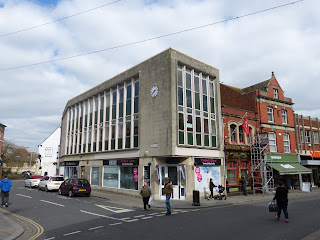Dr Foster went to Gloucester, in a shower of rain - I have also paid a visit, but for me the weather was quite good.
I didn't get to meet the Tailor of Gloucester, but I did see the clock on the old Co-op building on the corner of Eastgate Street and Brunswick Road.
Close by is the entrance to the Eastgate Shopping Centre. This rather grand entrance to a 1970's shopping centre was the original entrance to the market which stood on the site, although its new role this entrance was moved 25 feet along Eastgate Street.
Apparently there was a Beatrix Potter clock inside the centre. It was installed in 1994, but sadly removed in 2013.
A star of Gloucester is the clock on G A Baker & Son in Southgate Street.
Not only is there a clock with weathervane, but there is also a series of figures which ring the bells.
These figures are reported to be an Irishwoman, an Englishman, Old Father Time, a Scotsman and a Welshwoman.
A fine clock, a fine set of bells and bell ringers, and a fine shop front overall. It certainly gets my vote as the best shop premises in Gloucester.
The clock dates from 1904.
Further down Southgate Street is the next clock on what is now The Hub bistro (the words hub and bistro would both suggest that this was not the original use of the building, unless Gloucester was at the cutting edge of linguistic use).
On now to the docks. Gloucester gained formal status as a port in 1580, served by the River Severn, but it was not until the construction of the Gloucester and Sharpness Canal in 1827 that trade really took off.
This dockside building is now The Lord High Constable of England, a Wetherspoons pub.
I am not sure whether I should include this next clock, but here it is anyway. This is Quayside Clocks in Southgate Street.
We have done Eastgate Street and Southgate Street, so now it is the turn of Westgate Street. This is Avant Garde, a hair salon.
A bit further along is St Nicholas church. Originally dating from 1190, it has, as I often say, been through the usual re-buildings and modifications over the centuries. One unusual feature is its truncated spire, a result of being hit by cannon fire in 1643 during the Civil War.
Th clock itself dates from 1716.
And now to something a tad more modern. This building and its clock can be found on the corner of Hare Lane and Northgate Street (hurrah, we have completed all four points of the compass).
Continuing along Northgate Street, we come to St Peter's church on the junction of London Road and Black Dog Way. Which is a horrible dual-carriageway, sea of tarmac sort of a junction.
St Peter's was consecrated on 8 October 1868.
Re-tracing our steps along Northgate Street, we find the Debenhams store on the corner of The Oxebode.
At the other end of The Oxbode is the Post Office, with its window clock.
At which point we say good-bye to Gloucester.











































































































